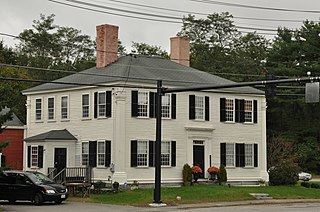
The John Robbins House is a historic house at 144 Great Road in Acton, Massachusetts. Built in 1800, it is a well-preserved example of a late Georgian/early Federal country house, and was the farmhouse for one of Acton's largest 19th-century farms. The interior includes well-preserved period details, including stencilwork by the itinerant artist Moses Eaton, Jr. The house was listed on the National Register of Historic Places on July 25, 2003.
The Free Will Baptist Church and Cemetery is a historic church property on Church Turn Road in North Islesboro, Maine. Built in 1843 and enlarged in the 1890s, the church is a fine example of Greek Revival architecture, and is particularly noted for its well-preserved mid-19th century stenciled artwork, whose quality and level of preservation are among the best in the state. The property was listed on the National Register of Historic Places in 1988. It is now owned by a local nonprofit organization.

Hall's Tavern, also once known as the Falmouth Tavern, and now the Quaker Tavern B&B and Inn, is an historic tavern at 377 Gray Road in Falmouth, Maine. Built about 1800 as a private home, it served for many years of the 19th century as a traveler accommodation, and is one of Falmouth's few surviving buildings of the period. It was listed on the National Register of Historic Places in 1978.

The Moses Kent House is a historic house on River Road in Lyme, New Hampshire. Built in 1811, it is a good local example of Federal period architecture, most notable for the well-preserved murals on its interior walls, drawn by the itinerant artist Rufus Porter. The house was listed on the National Register of Historic Places in 1984.
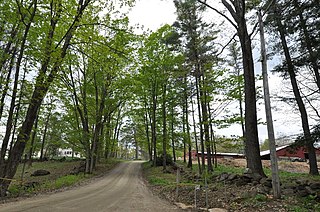
The John Adams Homestead/Wellscroft is a historic farmstead off West Sunset Hill Road in Harrisville, New Hampshire. The oldest portion of the farm's main house is a 1+1⁄2-story wood-frame structure built in the 1770s. It is one of the least-altered examples of early Cape style architecture in Harrisville, lacking typical alterations such as the additions of dormers and changes to the window sizes, locations, and shapes. The farmstead, including outbuildings and an area of roughly 2 acres (0.81 ha) distinct from the larger farm property, was listed on the National Register of Historic Places.

The Daniel Carr House is a historic house on Brier Hill Road in Haverhill, New Hampshire. Built about 1796, the house is most notable for the high quality folk murals drawn on its walls, most likely by the itinerant artist Rufus Porter between 1825 and 1830. The house was listed on the National Register of Historic Places in 1992.
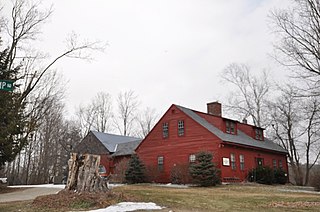
The Moses Eaton Jr. House is a historic house on Hancock Road in Harrisville, New Hampshire. Built about 1790, it is one of the oldest houses in the eastern part of Harrisville, and was home for fifty years to the itinerant folk stenciler Moses Eaton Jr. The house was listed on the National Register of Historic Places in 1988.
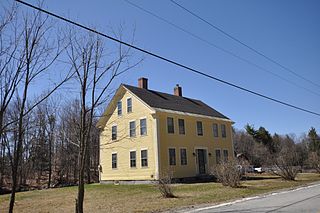
The John Richardson Homestead is a historic house on Hancock Road in Dublin, New Hampshire, United States. Built about 1798, it is a well-preserved example of a modest Federal period farmhouse. The house was listed on the National Register of Historic Places in 1983.

The Stone Farm is a historic farmhouse on Old Marlborough Road in Dublin, New Hampshire. Built about 1806 with several 19th-century alterations, it is a well-preserved example of a period farmhouse. The property was listed on the National Register of Historic Places in 1983.

The McClure-Hilton House is a historic house at 16 Tinker Road in Merrimack, New Hampshire. The oldest portion of this 1+1⁄2-story Cape style house was built c. 1741, and is one of the oldest surviving houses in the area. It was owned by the same family for over 200 years, and its interior includes stencilwork that may have been made by Moses Eaton Jr., an itinerant artist of the 19th century. The property also includes a barn, located on the other side of Tinker Road, which is of great antiquity. The property was listed on the National Register of Historic Places in 1989.

The Nathaniel and Elizabeth Bennett House, also locally known as the Cedarbrook Farm, is a historic house and farm property on the west side of Crockett Ridge Road in Norway, Maine, United States. The property is distinctive for its well-preserved Federal style house, including one room that contains an unusual form of stencil painting on its walls. It also has historic association with Don Carlos Seitz, the editor of the New York World, who operated a gentleman's farm on the property. It was listed on the National Register of Historic Places in 1996.
The Burgess House is a historic house on Burgess Road, just east of Austin Road in Sebec, Maine, United States. The oldest portion of this wood-frame house dates to about 1816, and was built by Ichabod Young, who erected the first fulling mill in Piscataquis County. The house is most remarkable for its high-quality interior woodwork, and for the artwork on the walls of several of its rooms, which includes paintings by Rufus Porter and stencilwork by Moses Eaton, Jr., two noted itinerant artists of the early-to-mid 19th century. The house was listed on the National Register of Historic Places in 1978.
The Straw House was a historic house, most recently a bed and breakfast inn called the Trebor Mansion Inn, at 11A Golda Court in Guilford, Maine. The elegant Queen Anne Victorian was built c. 1832, and extensively altered in the 1880s by David Straw to achieve its present appearance. An electrical fire in 2004 did extensive damage to the building, but it was largely restored to its 1880s appearance. Its walls featured artwork by the itinerant 19th-century artist Moses Eaton. The house was listed on the National Register of Historic Places in 1982. It was destroyed by fire in 2019, and was delisted in 2020.

The Grant Family House is a historic house at 72 Grant Street in Saco, Maine. Built in 1825, the house is a fine local example of Federal period architecture, but is most notable for an extensive series of well-preserved stenciled artwork on the walls of its hall and main parlor. The house was listed on the National Register of Historic Places in 1990.

The Hutchinson House is a historic house at 400 Alstead Center Road in Alstead, New Hampshire, United States. Built in 1805–09, it is one of a small number of Georgian houses in southwestern New Hampshire. It was added to the National Register of Historic Places in February 2015.

The Paul Family Farm is a historic farmstead at 106 Depot Road in Eliot, Maine. Consisting of a well-preserved early-19th century Federal style farmhouse and a small collection of early-20th century outbuildings, it is a representative example of 19th-century farming in the area. The farmhouse parlor is further notable for the c. 1820s stencilwork on its walls. The property was listed on the National Register of Historic Places in 1998.
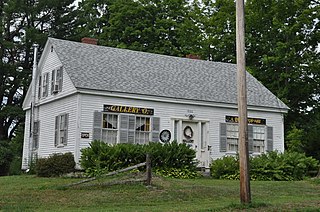
The Philip Leach House is a historic house on Bog Road in East Vassalboro, Maine. Built about 1805, it is a well-preserved local example of a Federal style Cape house. It is notable for the stencilwork and floor painting in its parlor, which are the work of the itinerant folk art stenciler Moses Eaton Jr. The house was listed on the National Register of Historic Places in 1983.

The John Williams House is a historic house located on Pond Road in Mount Vernon, Maine. Built in 1827, this modest Cape is regarded for its high quality interior woodwork, and well-preserved stencilwork attributed to folk artist Moses Eaton. The house was listed on the National Register of Historic Places on December 6, 1984.

The John Wilder House is a historic house on Lawrence Hill Road in the village center of Weston, Vermont. Built in 1827 for a prominent local politician, it is a distinctive example of transitional Federal-Greek Revival architecture in brick. Some of its interior walls are adorned with stencilwork attributed to Moses Eaton. The house was listed on the National Register of Historic Places in 1983.

Moses Eaton, Jr. was an American itinerant folk stencil artist. His home, with many examples of his work, was added to the National Register of Historic Places in 1988.




















